Ijraset Journal For Research in Applied Science and Engineering Technology
- Home / Ijraset
- On This Page
- Abstract
- Introduction
- Conclusion
- References
- Copyright
Mechanical and Tribological Behavior of AA 6082 with Hybrid Metal Matrix Composites
Authors: V. Bharatharajana, C. N. Muruganandam
DOI Link: https://doi.org/10.22214/ijraset.2022.40317
Certificate: View Certificate
Abstract
Among automobile manufacturers, in recent times, a paramount importance has been given to less fuel consumption of the vehicles by utilizing lightweight and high strength materials. Metal matrix composites (MMCs) have been used commercially in the automotive market for nearly twenty years. Metal Matrix Composites (MMCs) have very light weight, high strength, stiffness and exhibit greater resistance to corrosion, oxidation, and wear. Tensile and compressive strength is an especially important property of Aluminium matrix composites which is essential for automotive application. In this study hybrid Aluminium matrix composite was fabricated through crucible casting route. Zirconium di Oxide (ZrO2) and Egg shell particles were used as reinforcement phases for the present study. The hybrid MMC was prepared with varying the ZrO2 particles weight ratio ranging from 2% to 4% and Es were varied 3% to 5% fixed quantity 1% of magnesium. The various mechanical properties were investigated and compared with non-metal matrix alloy of Al6082. Finally medium level of reinforcement enhanced the tensile and compressive strength moderately.
Introduction
I. INTRODUCTION
A metal matrix composite (MMC) can be defined as a metallic matrix (usually an alloy of Al, Cu, Fe, Mg, Ti or Pb) containing three-dimensional inclusions (usually an oxide, carbide, or nitride). In these MMCs, the good ductility of the metallic alloy as the matrix material is retained while the modulus and strength of the composites are increased because of the reinforcement phases. By the correct combination of matrix material and reinforcements, MMCs can be tailored to give superior electrical, mechanical, and even chemical properties. This is especially important in cases when monolithic metals and alloys can no longer fulfill the increasingly stringent requirements demanded by designers and engineers in newer engineering applications.
A. Classification of Composites
Composite materials are classified
- On the basis of matrix material,
- On the basis of filler material.
B. On the basis of Matrix
- Metal Matrix Composites (MMC): Metal Matrix Composites are composed of a metallic matrix (Aluminum, magnesium, iron, cobalt, copper) and a dispersed ceramic (oxides, carbides) or metallic (lead, tungsten, molybdenum) phase.
- Ceramic Matrix Composites (CMC): Ceramic Matrix Composites are composed of a ceramic matrix and imbedded fibers of other ceramic material (dispersed phase).
C. Aluminum Use in the Auto Industry
Automakers lightened average car weights by about 25 percent, to about 3,000 pounds during 1978-80, doubling fuel economy and improving performance. Some industry analysts think that the average automobile will have to be lightened further, by 500 to 700 pounds (16 to 22 percent), to meet upcoming fuel efficiency and emissions requirements.
The corrosion resistance, strength, light weight, and ease of fabrication of aluminum have steadily increased its use by automakers. Currently, more than 100 auto parts are made from aluminum. These components include bumper systems, wheels, brakes, air-conditioning compressors, heat exchangers and radiators, engine cylinder heads, rocker arms, pistons, and engine blocks, steering and suspension systems, shock absorbers, transmissions, and drive train parts.
II. OBJECTIVES
A. Objectives of Present Work
The requirement of composite material has gained popularity in these days due to their various properties like low density, good wear resistance, good tensile strength, and good surface finish. Zirconium oxide is one of the least expensive and low-density reinforcement available in huge quantities as solid waste by-product in ceramic plant. The Hardness strength will also be taken into consideration. For the achievement of the above, an experimental set up is prepared where all the necessary inputs will be made. In this work a composite is developed by adding various mass percentage of zirconium oxide (ZrO2), in Aluminum metal by mass ratio with various percentages. The composite must be prepared by crucible casting technique and must be analyzed various mechanical properties.
III. MATERIALS AND METHODS
A. Introduction of AA6082
AA6082 has a good surface finish; high corrosion resistance is readily suited to welding and can be easily anodized. Most commonly available as T6 temper, in the T4 condition it has good formability.
Table I
Typical Chemical Composition for Aluminium Alloy 6082
|
Element |
Si |
Fe |
Cu |
Mn |
Mg |
Zn |
Ti |
Cr |
Al |
|
Min |
0.70 |
0.0 |
0.0 |
0.40 |
0.60 |
0.0 |
0.0 |
0.0 |
- |
|
Max |
1.30 |
0.50 |
0.10 |
1.00 |
1.20 |
0.20 |
0.10 |
0.25 |
Bal |
B. Zirconium Oxide
Sometimes known as zirconium (not to be confused with zircon), is a white crystalline oxide of zirconium. Its most naturally occurring form, with a monoclinic crystalline structure. A dopant stabilized cubic structured zirconia, cubic zirconia, is synthesized in various colours for use as a gemstone and a diamond stimulant. Zirconium dioxide is one of the most studied ceramic materials. ZrO2 adopts a monoclinic crystal structure at room temperature and transitions to tetragonal and cubic at higher temperatures.
C. Egg Shell
Eggshells were rinsed in water to remove the membrane and then packed in a circular stainless-steel tray. The rinsed eggshells contained in the tray were dried in the sun for 6 hours.The dried eggshells were crushed manually with the aids of hand compression and then finally pulverized in a planetary ball mill. This milling was done for 3hours after which the mill was off loaded. Reveals the eggshells in two different forms.
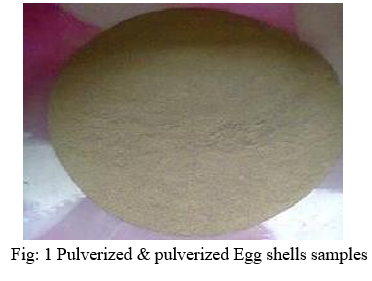
D. Magnesium
Since magnesium is less dense than aluminum, these alloys are prized for their relative lightness and strength. In human biology, magnesium is the eleventh-most-abundant element by mass in the human body. Magnesium ions are sour to the taste, and in low concentrations they help to impart a natural tartness to fresh mineral waters. In this composite ratio magnesium were mixed 1% for all ratios.
IV. CASTING PROCESS
In stir casting we use stirrer to agitate the molten metal matrix. The stirrer is generally made up of a material which can withstand at a higher melting temperature than the matrix temperature. Generally, graphite stirrer is used in stir casting. The stirrer is consisting of mainly two components cylindrical rod and impeller. The one end of rod is connected to impeller and other end is connected to shaft of the motor. The stirrer is generally held in a vertical position and is rotated by a motor at various speeds. The resultant molten metal is then poured in die for casting. Stir casting is suitable for manufacturing composites with up to 30% volume fractions of reinforcement.
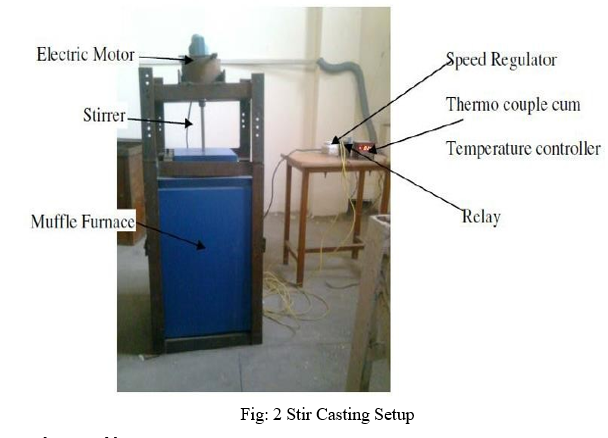
A. Material Requirement for Crucible Casting
Cylindrical Specimen size-2.5cm dia & Length-30cm
Rectangular Specimen:1.5x1.5x1.5 Cm
Volume-3.14/4*252*320*percentage of composite*density*percentage of excess of material
B. Mixing Ratio
Sample1: : AA6082 + 100%
Sample2: : AA6082 + ZrO2-2% + ES-3% + Mg-1% Sample3: : AA6082 + ZrO2-4% + ES-5% + Mg-1%
Table II
Mixing Ratio- Total AA 6082-600 GRAMS
|
Ratio |
AA 6082 grams |
ZrO2 weight percentage |
Egg Shell |
Mg 1% |
|
1 |
500 |
0 |
0 |
0 |
|
2 |
500 |
2%-10 |
3%-15 |
1% -5 |
|
3 |
500 |
4%-20 |
5%-25 |
1% -5 |
Rod Size-Dia-25 mm & Length-300 mm Rectangular-100x15x15
V. MECHANICAL TEST
A. Rockwell Hardness Test
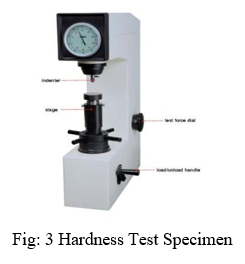
- Rockwell Hardness systems use a direct readout machine determining the hardness number based upon the depth of penetration of either a diamond point or a steel ball. Deep penetration indicated a material having a low Rockwell Hardness number.
- However, a low penetration indicates a material having a high Rockwell Hardness number.
B. Impact Test
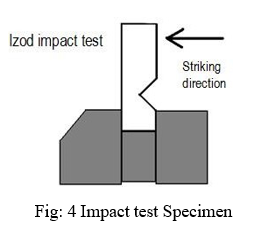
Izod impact strength testing is an ASTM standard method of determining impact strength. A notched sample is generally used to determine impact strength. Impact is a very important phenomenon in governing the life of a structure. In the case of aircraft, impact can take place by the bird hitting the plane while it is cruising, during take - off and landing there is impact by the debris present on the runway an arm held at a specific height (constant potential energy) is released. The arm hits the sample and breaks it. From the energy absorbed by the sample, its impact strength is determined.
C. Tensile Test & Elongation
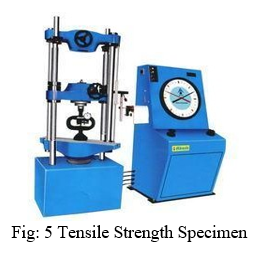
Friction processed joints are evaluated for their mechanical characteristics through tensile testing. A tensile test helps determining tensile properties such as tensile strength, yield strength, percentage of elongation, and percentage of reduction in area and modulus of elasticity.
VI. RESULT
A. Hardness Strength Value
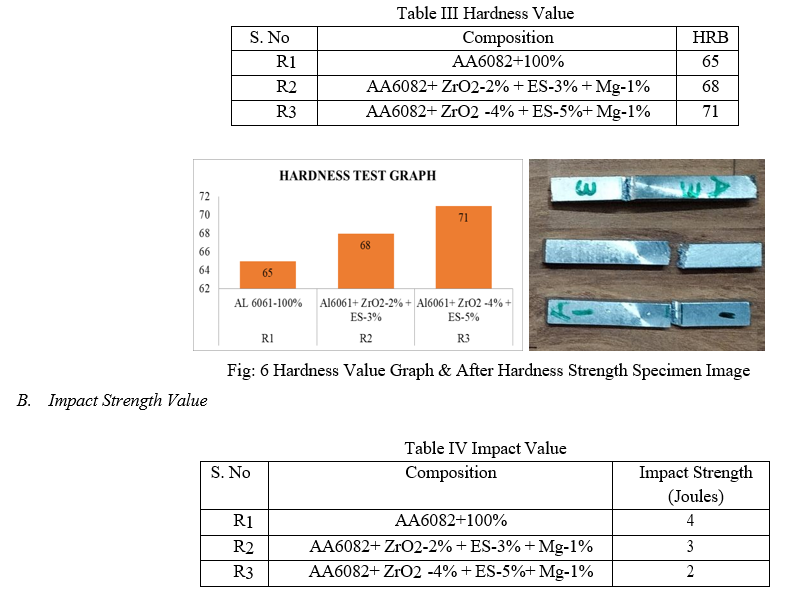
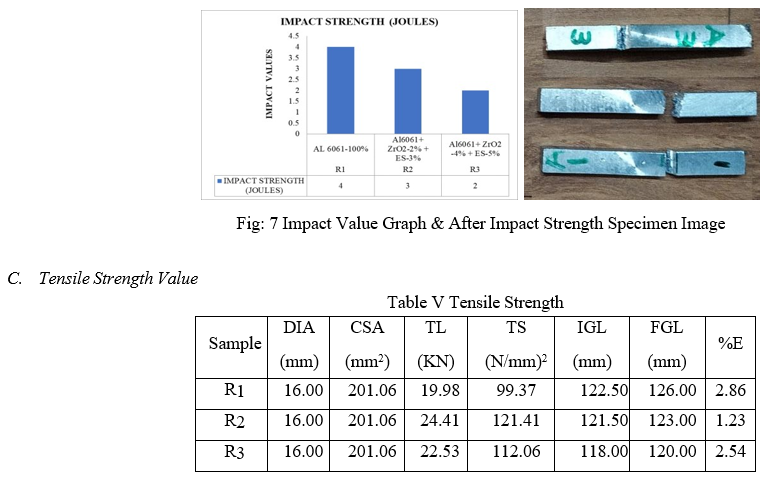
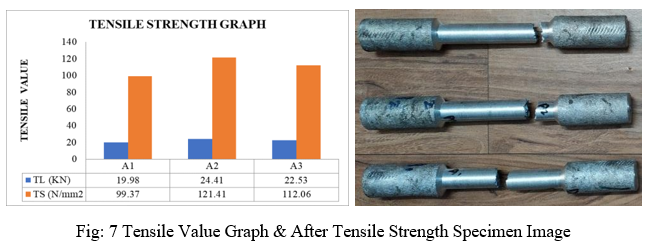
D. Wear Test
A tribometer is an instrument that measures tribological quantities, such as coefficient of friction, friction force, and wear volume, between two surfaces in contact. A tribotester is the general name given to a machine or device used to perform tests and simulations of wear, friction and lubrication which are the subject of the study of tribology. Often tribotester are extremely specific in their function and are fabricated by manufacturers who desire to test and analyze the long-term performance of their products. An example is that of orthopedic manufactures who have spent considerable sums of money to develop tribotester that accurately reproduce the motions and forces that occur in human hip joints so that they can perform accelerated wear tests of their products.
- Technical Specification of Wear Machine –Pin on Disc
Test Speed: 600RPM, Normal Load: 40N, Pin Dia: 10mm, Track Radius: 30mm WEAR RATE-sample-1, 2 & 3
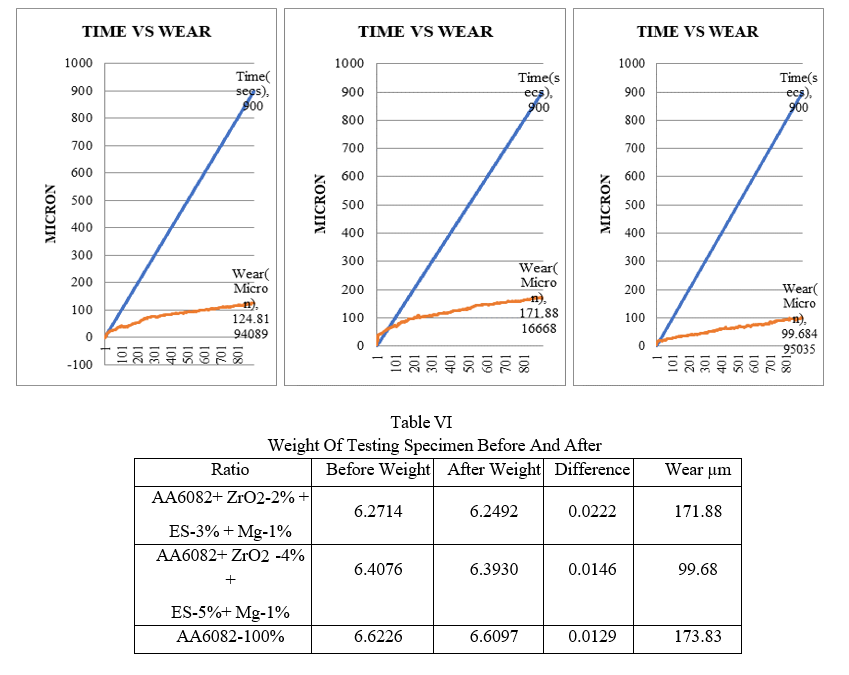
Conclusion
It is found that the zirconium di oxide and chicken eggshell (ZrO2 & ES) particles have been successfully incorporated in Al 6082 matrix alloy through crucible casting technique. It has been observed that the Tensile and compressive strength of composites increases with the addition of ZrO2 & ES particles and the maximum values were achieved at 2 & 3 wt% with constant 1% of Mg. And then observed that Hardness of composites increases with the addition of ZrO2 & ES particles and the maximum values were achieved at 4 & 5 wt%. Further increase of ZrO2 & ES particles in the matrix leads to increase in hardness and strength which may be due to the increased amount of trapped air thereby increasing the amount of pores. It has also been found that with the increase in amount of ZrO2 & ES reinforcement the density decreases. With the increase in ZrO2 & ES reinforcing particles in matrix, particle pulled out and particle-matrix debonding has been observed which lead to brittle fracture. Based on the wear test have found the wear rate the Ratio of AA6082+ ZrO2 -4% + ES-5%+ Mg-1% - is very low wear rate obtained during this investigation. These composites generally to be utilized for automobiles journal and frictional bearing.
References
[1] S.B. Hassan Wear behaviour of Al2618 alloy reinforced with Si3N4, AlN and ZrB2 in situ composites at elevated temperatures, Alexandria Engineering Journal (2016) 55, 19–36 [2] R.B yashonant sai Production and some properties of Si3N4reinforced aluminum alloy composites, Journal of Asian Ceramic Societies 3 (2015) 352–359 [3] Surendra Kumar Dwivedi Optimization of friction and wear behaviour of Al?Si3N4 nano composite and Al?Gr?Si3N4 hybrid composite under dry sliding conditions, Trans. Nonferrous Met. Soc. China 27(2017) 986?997 [4] Akbar Arab Hosseini AlSi11/ Si3N4 interpenetrating composites Tribology properties of aluminum matrix composites, 2012 world Congress on Engineering and Technology [5] Mohammad Abdullah Novel preparation of Al-5%Cu / BN and Si3N4 composites with analyzing microstructure, thermal and mechanical properties, Materials Characterization 136 (2018) 144–151 [6] J.O. Agunsoye Fabrication and Characterization of SiC and Si3N4 Reinforced Aluminum Matrix Composites, Universal Journal of Materials Science 5(4): 95-101, 2017 [7] Shashi Prakash Dwivedi Production and Characterization of AA7075- (Si3N4 + Gr) Stir Cast Hybrid Composites, [\\\"Queen\\\'s University Libraries, Kingston\\\"] at 03:35 27 January 2016 [8] Amba Chaitanya’s Preparation of Metal Matrix Aluminum Alloys Composites Reinforced by Silicon Nitride and Aluminum Nitride Through Powder Metallurgy Techniques, Materials Science Forum Vols. 727-728 (2012) pp 259-262.
Copyright
Copyright © 2022 V. Bharatharajana, C. N. Muruganandam . This is an open access article distributed under the Creative Commons Attribution License, which permits unrestricted use, distribution, and reproduction in any medium, provided the original work is properly cited.

Download Paper
Paper Id : IJRASET40317
Publish Date : 2022-02-12
ISSN : 2321-9653
Publisher Name : IJRASET
DOI Link : Click Here
 Submit Paper Online
Submit Paper Online

